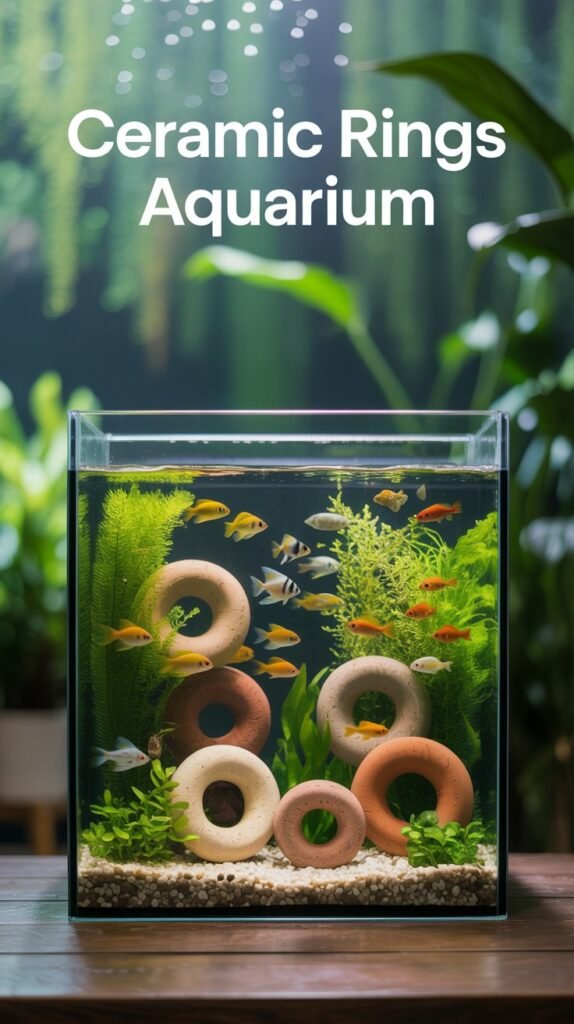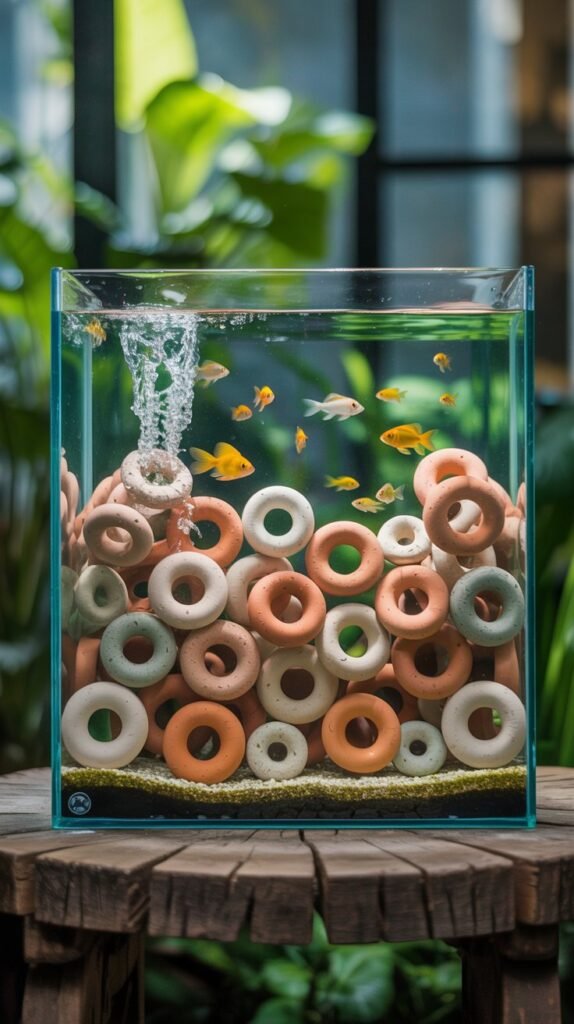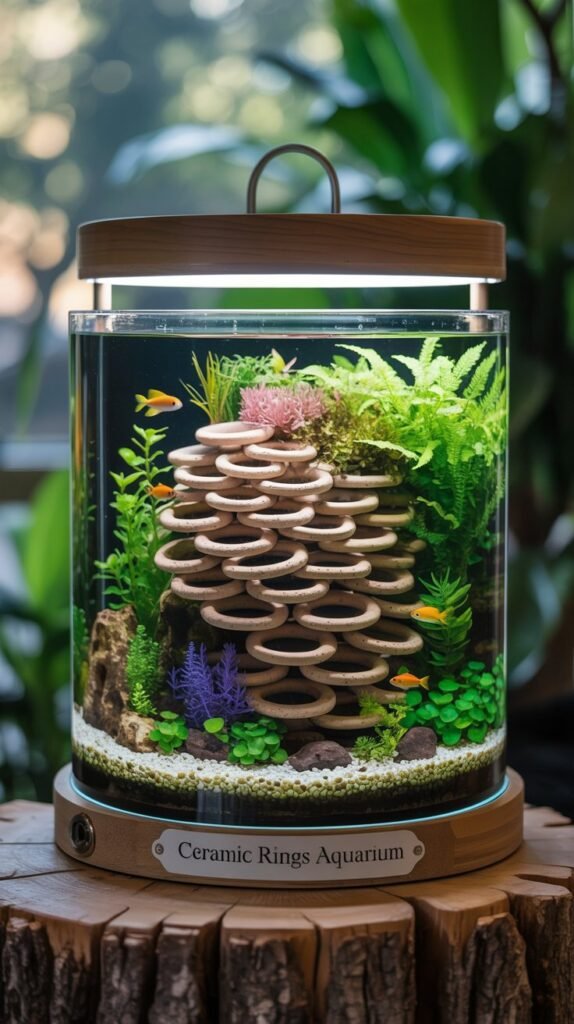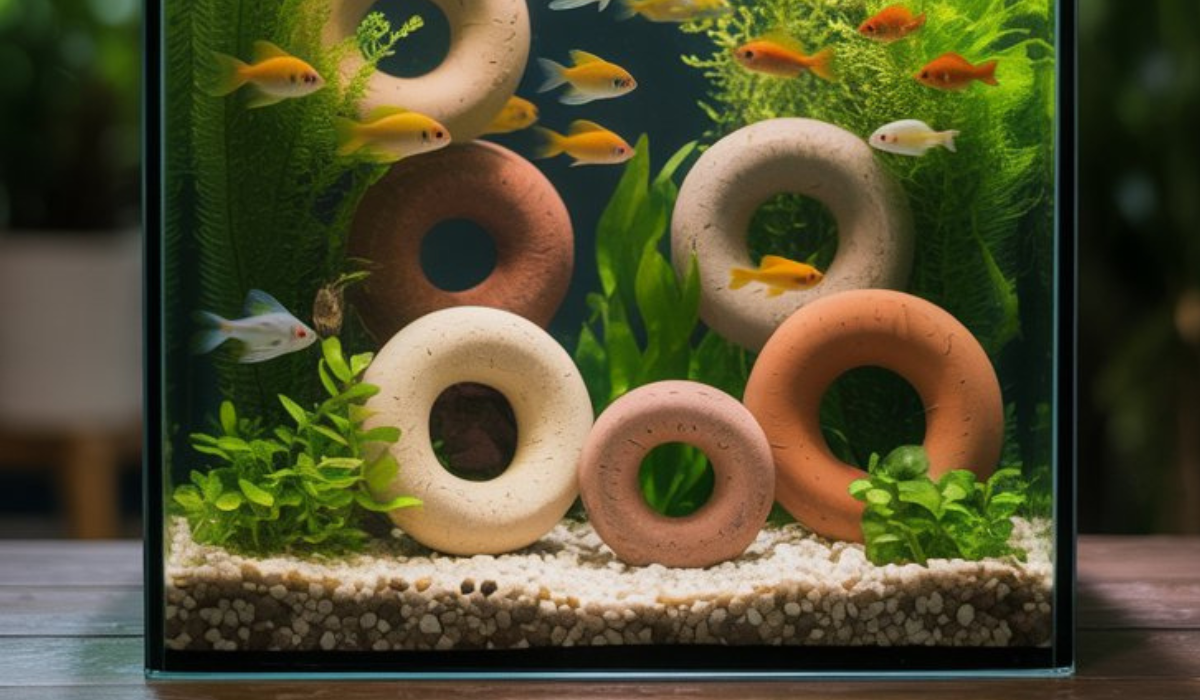Maintaining a healthy aquarium goes far beyond just adding water and fish. One of the most crucial components of a successful aquarium setup is biological filtration, and ceramic rings play a central role in that process. These small, porous rings may not look impressive, but they are the unsung heroes of a clean and balanced aquarium ecosystem.
In this comprehensive guide, we’ll explore everything about ceramic rings for aquariums — how they work, their benefits, how to use them properly, and how to maintain them for maximum efficiency. Whether you’re a beginner aquarist or an advanced hobbyist, understanding ceramic rings can drastically improve your tank’s water quality and fish health.
1. What Are Ceramic Rings in an Aquarium?
Ceramic rings are small, cylindrical pieces of porous ceramic material used in aquarium filters. Their main purpose is to provide surface area for beneficial bacteria to colonize and grow. These bacteria are responsible for breaking down toxic ammonia and nitrite — two harmful substances produced by fish waste, uneaten food, and decaying plant matter.
How They Look and Feel

Ceramic rings are typically:
- White, beige, or light brown in color
- Porous and rough in texture
- Hollow in the center to allow water flow
These rings are made from baked clay or ceramic materials, giving them a durable and porous structure — ideal for bacterial growth.
2. The Science Behind Ceramic Rings
To understand how ceramic rings work, you must first understand the nitrogen cycle in an aquarium.
When fish produce waste, ammonia is released into the water. Ammonia is extremely toxic to fish, even in small concentrations. In a well-established aquarium, beneficial bacteria convert:
- Ammonia (NH₃) → Nitrite (NO₂⁻)
- Nitrite (NO₂⁻) → Nitrate (NO₃⁻)
This process is called biological filtration.
Ceramic rings act as a home for these beneficial bacteria. Their porous surface provides millions of microscopic spaces where bacteria can thrive, safely breaking down waste and stabilizing water chemistry.
3. Why Ceramic Rings Are Essential in Aquariums
Here are the main reasons ceramic rings are considered one of the best filter media options:
a. Excellent Biological Filtration
Ceramic rings create an ideal environment for beneficial bacteria to colonize. This keeps ammonia and nitrite levels in check, ensuring a stable nitrogen cycle.
b. Large Surface Area
Thanks to their porous design, ceramic rings offer an enormous surface area for bacteria compared to smooth materials like glass or plastic.
c. Improved Water Clarity
By promoting bacterial activity and breaking down toxins, ceramic rings help maintain crystal-clear water that’s safe for fish and plants.
d. Long-Lasting Durability
Ceramic rings are hard and non-degradable, meaning they can last for years before needing replacement.
e. Low Maintenance
They require minimal cleaning — a simple rinse during water changes keeps them functional without killing beneficial bacteria.
4. How Ceramic Rings Work in Aquarium Filtration
Ceramic rings are primarily used as biological media, but they also serve a small mechanical filtration role.
Step-by-Step Process
- Water Flow: As water passes through the filter, it moves over and through the ceramic rings.
- Waste Capture: Large debris and particles are trapped on the outer layer of the rings.
- Bacterial Breakdown: Inside the pores, beneficial bacteria break down harmful ammonia and nitrite.
- Clean Water Return: The filtered, cleaner water flows back into the aquarium.
This continuous cycle keeps the aquarium environment safe and balanced.
5. Placement of Ceramic Rings in the Filter
Proper placement is crucial for effective filtration. Ceramic rings should always be placed after mechanical media (like filter sponges or floss) and before chemical media (like activated carbon).
Typical Filter Setup Order:
- Mechanical media (sponge, filter pad) — traps large particles
- Biological media (ceramic rings, bio balls) — hosts beneficial bacteria
- Chemical media (activated carbon, zeolite) — removes odors and discoloration
This arrangement ensures that only clean, debris-free water reaches the ceramic rings, maximizing bacterial efficiency.
6. Types of Ceramic Rings
Not all ceramic rings are made equal. Here are the main types available:
a. Standard Ceramic Rings
These are the most common and affordable type, offering excellent surface area for bacterial growth.
b. Nano Ceramic Rings
Smaller in size, these rings are perfect for nano tanks and small filters.
c. High-Grade Porous Ceramic Media
These premium rings have ultra-fine pores, providing even greater surface area for bacterial colonization.
d. Sintered Glass Rings
Although technically not ceramic, sintered glass media work similarly and are known for their superior porosity and durability.
7. Benefits of Using Ceramic Rings

Let’s dive deeper into the advantages of ceramic rings for aquariums.
1. Stable Water Parameters
Ceramic rings maintain biological balance, keeping ammonia and nitrite at zero and ensuring long-term stability.
2. Healthier Fish
Fish thrive in stable environments. Ceramic rings reduce toxic buildup, minimizing stress and disease risk.
3. Low Replacement Cost
Once purchased, they can last for years with simple maintenance.
4. Natural Biological Ecosystem
They mimic the natural filtration process found in rivers and lakes, supporting a more self-sustaining tank.
5. Compatible with All Filters
Ceramic rings work with:
- Canister filters
- Hang-on-back filters
- Sump filters
- Sponge filters (in hybrid setups)
8. How to Use Ceramic Rings in Your Aquarium
Using ceramic rings correctly ensures optimal performance.
Step 1: Rinse Before Use
Rinse the rings thoroughly under aquarium water or dechlorinated tap water to remove dust or debris.
Step 2: Place in Filter Media Bag
Put the rings in a mesh filter bag for easy maintenance and placement.
Step 3: Position in Filter
Place them in the biological media section of your filter setup, after mechanical media.
Step 4: Allow Time for Bacteria Growth
Beneficial bacteria take 4–6 weeks to establish colonies. Avoid washing or replacing all rings at once during this period.
9. Maintenance Tips for Ceramic Rings
While ceramic rings are low-maintenance, they still require periodic care to remain effective.
1. Rinse During Water Changes
Every few weeks, gently rinse them in old aquarium water to remove sludge and debris without killing beneficial bacteria.
2. Avoid Tap Water
Chlorine in tap water can kill beneficial bacteria. Always use tank water for cleaning.
3. Never Replace All Rings at Once
Replace only 25–50% of your ceramic rings at a time, allowing bacteria to recolonize the new media.
4. Check for Wear
Over time, rings may crumble or lose porosity. Replace them every 12–18 months for optimal performance.
10. Common Mistakes to Avoid
Here are some pitfalls to avoid when using ceramic rings:
- Washing with tap water — destroys bacteria colonies
- Replacing all at once — causes ammonia spikes
- Blocking water flow — overstuffing the filter can reduce efficiency
- Ignoring buildup — too much sludge can clog pores and reduce filtration
Avoiding these mistakes will keep your ceramic rings working efficiently for years.
11. Ceramic Rings vs Other Biological Media
Let’s compare ceramic rings with other common biological media:
| Feature | Ceramic Rings | Bio Balls | Lava Rock | Sintered Glass |
|---|---|---|---|---|
| Porosity | High | Medium | Very High | Very High |
| Bacterial Surface Area | Excellent | Good | Excellent | Superior |
| Durability | Long-lasting | Very durable | Can erode | Long-lasting |
| Ease of Cleaning | Easy | Easy | Harder | Easy |
| Cost | Affordable | Moderate | Cheap | Expensive |
While sintered glass offers the highest surface area, ceramic rings strike the perfect balance between cost, performance, and availability, making them ideal for most aquariums.
12. Are Ceramic Rings Suitable for All Aquariums?

Yes! Ceramic rings are versatile and can be used in almost any aquarium setup.
a. Freshwater Tanks
Perfect for tropical, community, and planted tanks. They help stabilize ammonia and nitrite levels.
b. Saltwater Tanks
They work well in marine tanks, though you should combine them with live rock for complete biological filtration.
c. Shrimp Tanks
Shrimp benefit from clean, stable water. Ceramic rings also serve as grazing surfaces for biofilm.
d. Pond Filters
Ceramic rings can be used in small ponds or outdoor aquariums to support beneficial bacteria.
13. How Many Ceramic Rings Do You Need?
The amount depends on tank size and bioload (number of fish).
| Tank Size | Recommended Amount |
|---|---|
| 10–20 gallons | 250–500 grams |
| 30–50 gallons | 1–2 kg |
| 60–100 gallons | 3–5 kg |
| 100+ gallons | 5–8 kg |
Most ceramic rings are sold in 1 kg bags, suitable for medium-sized aquariums.
14. Environmental Benefits
Ceramic rings are eco-friendly and reusable. Unlike disposable filter cartridges, they reduce waste and promote sustainable fishkeeping. Their durability means fewer replacements, conserving resources and saving money over time.
15. Troubleshooting: When Ceramic Rings Stop Working
If your aquarium’s water turns cloudy or ammonia spikes despite ceramic rings, check the following:
- Rings are clogged — rinse them gently.
- Filter flow is blocked — clean or rearrange media.
- Bacteria colony was destroyed — possibly due to tap water rinsing.
- Overfeeding — excessive waste overwhelms bacteria.
Restoring proper filtration and re-establishing bacterial colonies usually solves the issue.
16. Cost and Availability
Ceramic rings are inexpensive and widely available in pet stores and online.
- Average price: $8–$20 per kg
- Premium brands: $25–$40 per kg
They’re available from trusted brands like Seachem Matrix, Fluval Biomax, Eheim Substrat Pro, and AquaClear Ceramic Rings.
17. How Long Do Ceramic Rings Last?
With proper maintenance, ceramic rings can last 1–2 years or more. Replace them when:
- They become brittle or crumble easily.
- Pores clog permanently, reducing water flow.
- Water parameters become unstable despite maintenance.
18. DIY Ceramic Ring Alternatives
If you prefer DIY solutions, you can use alternatives like:
- Lava rock: Cheap and porous, though messier to clean.
- Pumice stone: Lightweight and effective.
- Sintered glass pebbles: Excellent surface area for bacteria.
However, ceramic rings remain the most balanced option in terms of cost, performance, and ease of use.
19. Final Thoughts
The ceramic ring may seem like a simple object, but it plays a critical role in maintaining your aquarium’s ecosystem. Acting as the foundation for biological filtration, ceramic rings keep water clean, clear, and toxin-free.
By providing a massive surface area for beneficial bacteria, they ensure your fish live in a stable and healthy environment. Whether you’re running a 10-gallon nano tank or a 100-gallon community setup, ceramic rings are an indispensable part of your aquarium filtration system.
With minimal maintenance, affordable cost, and reliable performance, ceramic rings remain one of the most valuable tools for any aquarist.
FAQs About Ceramic Rings in Aquariums
1. What do ceramic rings do in an aquarium?
Ceramic rings provide surface area for beneficial bacteria to grow, helping break down toxic ammonia and nitrite into less harmful substances.
2. How often should I clean ceramic rings?
Every 3–4 weeks, rinse them gently using tank water to remove buildup while preserving bacteria.
3. Can I wash ceramic rings with tap water?
No. Tap water contains chlorine, which kills beneficial bacteria. Always use aquarium water.
4. How long do ceramic rings last?
They can last 1–2 years or more, depending on water quality and maintenance frequency.
5. Do ceramic rings need to be replaced?
Yes, but only partially. Replace 25–50% at a time to maintain bacterial balance.
6. Are ceramic rings better than bio balls?
Both work well, but ceramic rings offer greater surface area and are better for compact filters.
7. Can ceramic rings be used in a saltwater tank?
Yes, they work great in saltwater systems but should be combined with live rock for optimal results.
8. Are ceramic rings necessary in planted tanks?
Yes, they help stabilize water chemistry, supporting both plant and fish health.
9. Can I use ceramic rings without a filter?
They’re most effective inside a filter with water flow. Without it, bacteria colonies won’t function efficiently.
10. Do ceramic rings make water clear?
Indirectly, yes. By supporting beneficial bacteria, they keep water chemistry stable, reducing cloudiness and improving clarity.

